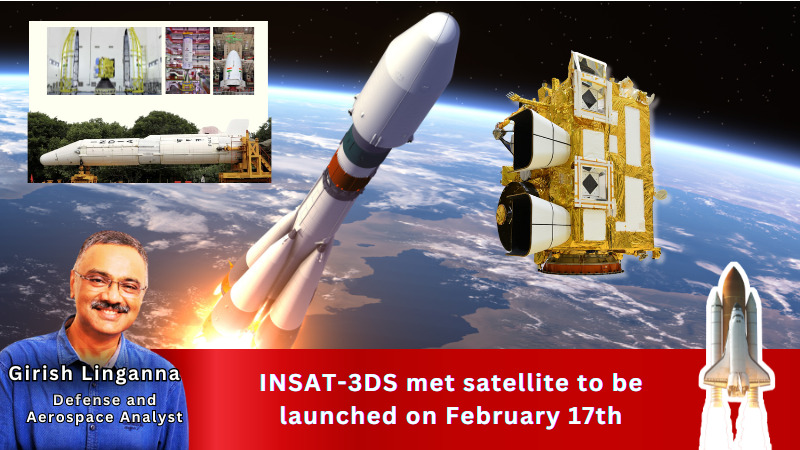
INSAT-3DS satellite will be sent into space
The Indian Ministry of Earth Sciences (MoES) is funding the satellite
The satellite is equipped with a Satellite Aided Search & Rescue (SAS&R) transponder
The Indian Space Research Organisation (ISRO) kicked off 2024 with a launch on the first day of the year. Now, they are all set for their second mission of the year, planned for 5:30 pm Indian Standard Time on February 17th. This will be the 16th flight for their GSLV rocket, previously called GSLV Mk2. This time, the rocket will send the INSAT-3DS satellite into space. The purpose of this satellite is to improve weather observations and keep an eye on the land and ocean. This will help in predicting the weather more accurately and providing early warnings for natural disasters.
The Indian Ministry of Earth Sciences (MoES) is funding the satellite. It will join the earlier satellites, INSAT-3D (launched in 2013) and INSAT-3DR, to improve weather services (2016).
About 20 minutes after starting its journey, the 420-ton GSLV rocket will put the satellite into an orbit around the Earth that looks like an egg (Geo Transfer Orbit). Then, using its own engines, the satellite will move into a round orbit far above the Earth, nearly 36,000 km away, known as a geostationary orbit.
Satellites look like they’re not moving when you see them from a certain spot on Earth because they move together with how the Earth rotates or turns.
Several branches of the Ministry of Earth Sciences (MoES), including the Indian Meteorological Department (IMD), National Centre for Medium-Range Weather Forecasting (NCMRWF), Indian Institute of Tropical Meteorology (IITM), National Institute of Ocean Technology (NIOT), Indian National Center for Ocean Information Services (INCOIS), along with other agencies and institutes, will utilize data from the INSAT-3DS Satellite to enhance weather predictions and meteorological services.
Besides its weather-focused capabilities, the satellite is equipped with a Satellite Aided Search & Rescue (SAS&R) transponder. This means, for instance, fishermen with compatible devices can transmit SOS messages to the satellite, which then relays these messages to the appropriate organizations for a rescue operation. Positioned far above the Earth, the satellite can oversee about one-third of the planet’s surface, providing broader coverage than satellites in closer orbits.
(The author Girish Linganna is a Defence, Aerospace & Political Analyst based in Bengaluru. He is also Director of ADD Engineering Components, India, Pvt. Ltd, a subsidiary of ADD Engineering GmbH, Germany. You can reach out to him at: [email protected])

INSAT-3DS satellite will be sent into space
The Indian Ministry of Earth Sciences (MoES) is funding the satellite
The satellite is equipped with a Satellite Aided Search & Rescue (SAS&R) transponder
The Indian Space Research Organisation (ISRO) kicked off 2024 with a launch on the first day of the year. Now, they are all set for their second mission of the year, planned for 5:30 pm Indian Standard Time on February 17th. This will be the 16th flight for their GSLV rocket, previously called GSLV Mk2. This time, the rocket will send the INSAT-3DS satellite into space. The purpose of this satellite is to improve weather observations and keep an eye on the land and ocean. This will help in predicting the weather more accurately and providing early warnings for natural disasters.
The Indian Ministry of Earth Sciences (MoES) is funding the satellite. It will join the earlier satellites, INSAT-3D (launched in 2013) and INSAT-3DR, to improve weather services (2016).
About 20 minutes after starting its journey, the 420-ton GSLV rocket will put the satellite into an orbit around the Earth that looks like an egg (Geo Transfer Orbit). Then, using its own engines, the satellite will move into a round orbit far above the Earth, nearly 36,000 km away, known as a geostationary orbit.
Satellites look like they’re not moving when you see them from a certain spot on Earth because they move together with how the Earth rotates or turns.
Several branches of the Ministry of Earth Sciences (MoES), including the Indian Meteorological Department (IMD), National Centre for Medium-Range Weather Forecasting (NCMRWF), Indian Institute of Tropical Meteorology (IITM), National Institute of Ocean Technology (NIOT), Indian National Center for Ocean Information Services (INCOIS), along with other agencies and institutes, will utilize data from the INSAT-3DS Satellite to enhance weather predictions and meteorological services.
Besides its weather-focused capabilities, the satellite is equipped with a Satellite Aided Search & Rescue (SAS&R) transponder. This means, for instance, fishermen with compatible devices can transmit SOS messages to the satellite, which then relays these messages to the appropriate organizations for a rescue operation. Positioned far above the Earth, the satellite can oversee about one-third of the planet’s surface, providing broader coverage than satellites in closer orbits.
(The author Girish Linganna is a Defence, Aerospace & Political Analyst based in Bengaluru. He is also Director of ADD Engineering Components, India, Pvt. Ltd, a subsidiary of ADD Engineering GmbH, Germany. You can reach out to him at: [email protected])
